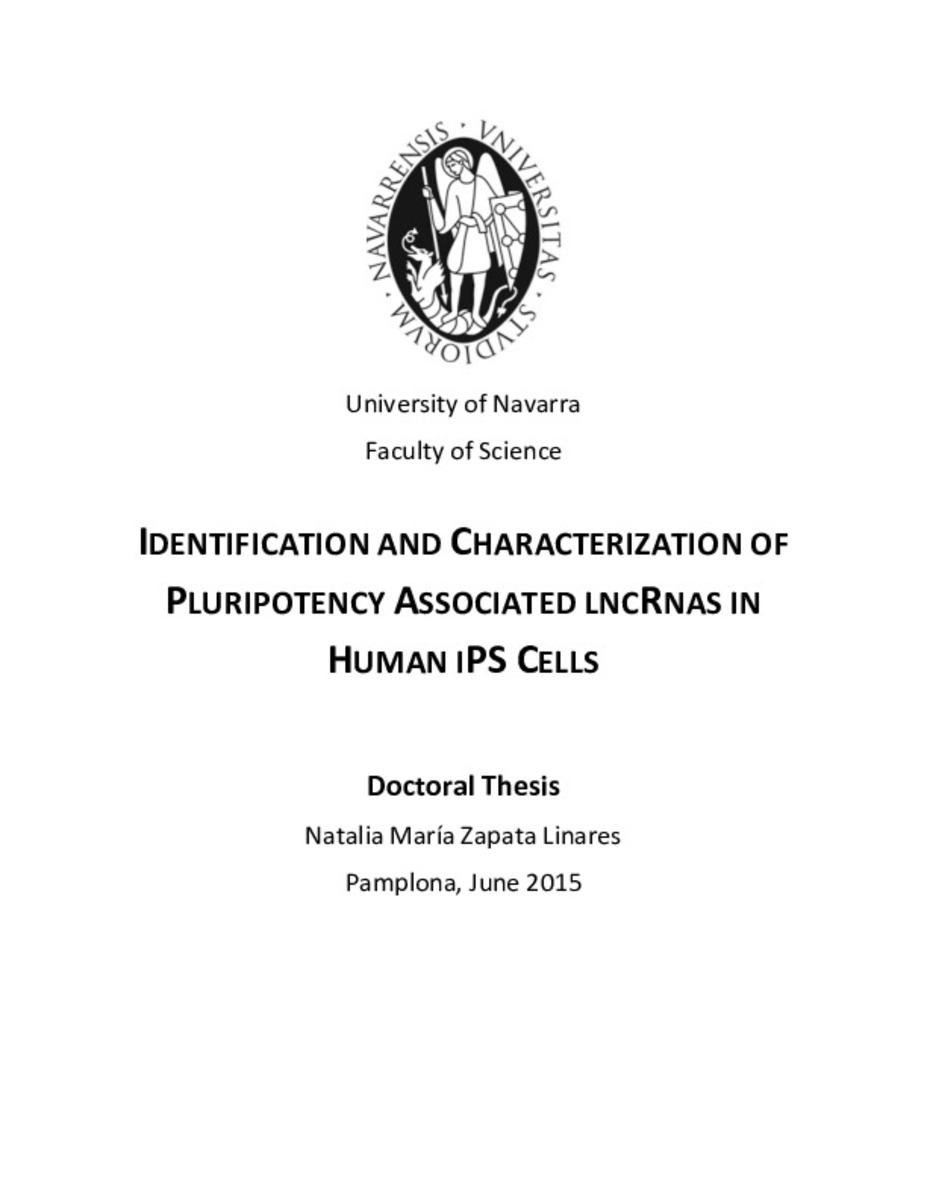Full metadata record
| DC Field | Value | Language |
|---|---|---|
| dc.contributor.advisor | Prosper-Cardoso, F. (Felipe) | - |
| dc.creator | Zapata-Linares, N.M. (Natalia María) | - |
| dc.date.accessioned | 2015-09-08T10:36:51Z | - |
| dc.date.available | 2015-09-08T10:36:51Z | - |
| dc.date.issued | 2015 | - |
| dc.date.submitted | 2015-06-24 | - |
| dc.identifier.citation | ZAPATA LINARES, Natalia María. ""Identification and Characterization of pluripotency associated IncRNAs in human iPS cells"". Prósper, Felipe (dir.), Rodríguez Madoz, Juan Roberto (codir.). Tesis doctoral. Universidad de Navarra, Pamplona, 2015 | es_ES |
| dc.identifier.uri | https://hdl.handle.net/10171/38979 | - |
| dc.description.abstract | Induced pluripotent stem cells (iPSCs) are an attractive source of stem cells for many applications like patient-specific cell therapy, disease modeling or drug screening. Generation of iPSCs by cellular reprogramming is a complex and highly inefficient process that involves a high number of genetic and epigenetic modifications most of them unknown. Those genetic modifications include both coding and non-coding genes like long non-coding RNAs (lncRNAs). A detailed knowledge of the factors that make a cell to return to its own origin would help to a deeper understanding of the reprogramming process and to address new strategies that solve the current problems within this field. LncRNAs have been found to be involved in a wide variety of cellular processes, including embryonic development and cancer. Recently, some lncRNAs have been described as markers of the pluripotent state in addition to enhance the efficiency of somatic cells reprogramming. In order to further our knowledge in the reprogramming mechanisms mediated by lncRNAs, the expression profile of coding and non-coding genes was evaluated in fully characterized human iPSC clones generated from freshly isolated human fibroblasts and ADSCs by retroviral induction of POU5F1, SOX2, KLF4 and c-MYC. After the evaluation of differentially expressed lncRNAs between iPSCs derived from ADSCs and their parental cells 37 lncRNAs associated to the pluripotent state (PALs) were identified. Eleven of those PALs were fully characterized being all of them up-regulated in a considerable number of different pluripotent cells, a behavior characteristic of the un-differentiated stem cell state. Four out of the 11 PALs decrease their expression in both Fib-hiPSCs and ADSCs-hiPSCs submitted to differentiation cues. Finally, PAL20 and PAL21 were identified as the most robust candidates due to their high expression in all pluripotent stem cells analyzed and their dramatic and promptly depletion upon spontaneous differentiation. Gain of function and loss of function analysis confirmed that the induction of PAL20 and PAL21 expression is required for the establishment of ES-like colonies. On the other hand, silencing of those transcripts reduced the expression of specific pluripotent markers; lead to mild increase of specific lineage markers as well as a decrease on the proliferation rate of pluripotent cells. | es_ES |
| dc.language.iso | eng | es_ES |
| dc.rights | info:eu-repo/semantics/openAccess | es_ES |
| dc.subject | Biología celular | es_ES |
| dc.subject | Cultivo de tejidos | es_ES |
| dc.subject | Biología molecular | es_ES |
| dc.title | Identification and Characterization of pluripotency associated IncRNAs in human iPS cells | es_ES |
| dc.type | info:eu-repo/semantics/doctoralThesis | es_ES |
Files in This Item:
Statistics and impact
Items in Dadun are protected by copyright, with all rights reserved, unless otherwise indicated.






